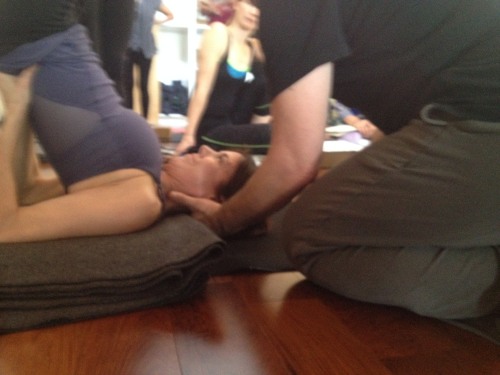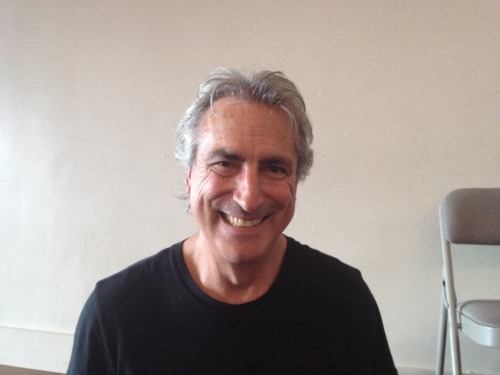Beauty is not superficial; Beauty is ‘resonance’ with the Universe.
– Kevin Ashton
“When we create something that is truly going to work and succeed, we always see that resonance and we’re going to recognize it.”
Beauty is not superficial; Beauty is ‘resonance’ with the Universe.
– Kevin Ashton
“When we create something that is truly going to work and succeed, we always see that resonance and we’re going to recognize it.”
Known as The Mother of all yoga asanas:)
(Photo here – request it please.)
Insertion of that rolled mat – never thought of it – NICE – No detail seems to escape him – Thank you Richard Rosen for that idea – really prevents the slippage. Also this Iyengar-studioesque blankets are nice – so NOT-sliding and rolling out from under you, solid feel.
I love shoulder stands – Salamba Sarvāngāsana – but going into counter-pose, Matsyasana (fish), I had this odd pain which I carried all day… cause for concern? No blankets, no props, just threw myself into it by flipping up into it to save “time”…and actually from “ego” – hey, I’m an advanced student – I don’t need any props – just do it – reverting back to that immature mentality still. & learned a lesson. It’s YOUR cervical spine with that spinal cord (connects your brain to rest of the body) , it’s YOUR throat that houses your thyroid gland …and review – why is thyroid gland important?
The thyroid gland covers the windpipe from three sides. The hormones of the Thyroid gland, T3 & T4, help the body to produce & regulate adrenaline, ephinephrine, and dopamine; all three of which are active in brain chemistry. Other hormones from this gland also help regulate metabolism. Without a functional thyroid, the body would not be able to break down proteins, and it would not be able to process carbohydrates and vitamins. For this reason, glandular problems can lead to uncontrollable weight gain. (sourced from http://www.healthline.com/human-body-maps/thyroid-gland)
& the throat houses your Vishuddha chakra:
Vishuddha chakra is known as the purification center, where the nectar amrita drips down from the Bindu chakra and is split into a pure form and a poison. In its most abstract form, it is associated with higher discrimination, and is associated with creativity and self-expression. It is believed that when Vishuddha is closed, we undergo decay and death. When it is open, negative experiences are transformed into wisdom and learning. The success and failure in one’s life depend upon the state of this chakra (whether it is polluted or clean). Guilty feeling is the most prominent reason for this chakra to block the Kundalini energy moving upwards.It is associated with the element Akasha, or Æther, and the sense of hearing, as well as the action of speaking. Meditation upon this chakra is said to bring about the following siddhis or occult powers: vision of the three periods, past, present and future; freedom from disease and old age; destruction of dangers; and the ability to move the three worlds.(source from Varenne, Jean (1989). Yoga and the Hindu Tradition )
Here’s an excerpt from Marcus Julian Felicetti’s article in Elephant Journal on 10 specific benefits of practicing this particular pose every day:
1. It bathes the lymph nodes in fresh lymph by increasing the circulation around the lymphatic system. This nourishes the whole body.
2. Inverting the body from the neck up means that gravity increases the venous blood flow to the heart, brain and eyes. This relaxes the heart and decreases the heart rate, and it brings clarity to the mind and sight.
3. It lengthens the spinal nerves, which relieves tension in the head, neck and shoulders.
4. According to the authoritative text, Light on Yoga, B.K.S. Iygenar states, “persons suffering from breathlessness, palpitation, asthma, bronchitis and throat ailments get relief from this posture.”
5. It is excellent for those suffering from thyroid disorders. Shoulder stand brings balance and regulates the hormone secretion of both the thyroid and parathyroid glands in the neck. This indirectly is very good for flexibility.
6. It soothes the nervous system. This is an excellent posture for those who suffer from stress, tension, anxiety (high blood pressure, only if it is taught by an expert yoga teacher) and shortness of temper.
7. It is excellent for sleep. Shoulder stand helps those who are suffering from insomnia.
8. It increases energy when practiced in the mornings. It lifts and sustains one’s energy levels dramatically when practiced every day. Therefore, it is especially good for those suffering from a fatigued body and mind.
9. It is excellent for fat loss. It increases the metabolism. It strengthens digestion by returning “agni” (fire) to the abdominal organs—liver, spleen, pancreas and stomach.
10. When done correctly shoulder stand tones the muscles of the gluteus, back, thighs and abdominals. This will benefit your balance and stability.
There are many other benefits of shoulder stand. These are just a few of the main ones.
Women should not practice shoulder stand during menstruation. There are also contraindications for shoulder stands if you have neck pain or injury, so shoulder stand should only be practiced under the guidance of a good yoga teacher.
************************************************************************************************************
So… wonder why I love this pose ? But evolved to doing it with TLC of this body temple that houses the divine truth:) Take loving care and have a lovely day filled with dance, laughter and joy:)
Sat Nam !

Shoulder stand can pose a risk so feel and measure how much of a padding you need … 2, 3, 4 even 5 blankets… use whatever your body needs.
Just a neck – it’s actually a very delicate and vital part of our spine – so if needed customize:)
 Richard Rosen, the master. To learn from someone so knowledgeable is an honor. What draws me to him is his unique depth of knowledge he shares with modesty and light-heartedness… still you have “AH-Ha”moments with his very detailed explanations and insights. Shocked when he stated nonchalantly … that he has suffered from Parkinson’s Disease for last 15 years – so can’t do some stuff – he says and shrugs. Still teaching. Still doing yoga. Still practicing. So what if he cannot do some asanas anymore – he can certainly explain it to such fine logical detail and students are all so willing to be a model for the demos – There’s so much to learn from him as he carries with him a treasure trove – that is a wealth of knowledge he accumulated over decades of teaching. Basically, a walking yoga philosophy and Sanskrit scholar and yoga historian. Maybe because he’s from Berkeley, he reminds me of a Cal Professor. I wish I were able to take his class on a more regular basis …
Richard Rosen, the master. To learn from someone so knowledgeable is an honor. What draws me to him is his unique depth of knowledge he shares with modesty and light-heartedness… still you have “AH-Ha”moments with his very detailed explanations and insights. Shocked when he stated nonchalantly … that he has suffered from Parkinson’s Disease for last 15 years – so can’t do some stuff – he says and shrugs. Still teaching. Still doing yoga. Still practicing. So what if he cannot do some asanas anymore – he can certainly explain it to such fine logical detail and students are all so willing to be a model for the demos – There’s so much to learn from him as he carries with him a treasure trove – that is a wealth of knowledge he accumulated over decades of teaching. Basically, a walking yoga philosophy and Sanskrit scholar and yoga historian. Maybe because he’s from Berkeley, he reminds me of a Cal Professor. I wish I were able to take his class on a more regular basis …
Thought the following describes him well – some beauty is skin deep and fleeting with age; the kind of beauty I am in awe of is …the kind that transcends the superficial – it’s like an aura. A very quiet, unassuming … and modest presence that exudes fatherly warmth and intellect. It’s subtle…
“The most beautiful people we have known are those who have known defeat, known suffering, known struggle, known loss, and have found their way out of the depths. These persons have an appreciation, a sensitivity, and an understanding of life that fills them with compassion, gentleness, and a deep loving concern. Beautiful people do not just happen.”
― Elisabeth Kübler-Ross